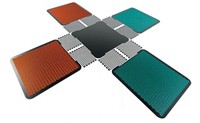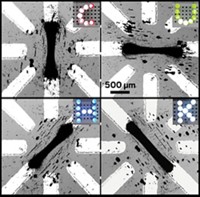Advertisement
Grab your lab coat. Let's get started
Welcome!
Welcome!
Create an account below to get 6 C&EN articles per month, receive newsletters and more - all free.
It seems this is your first time logging in online. Please enter the following information to continue.
As an ACS member you automatically get access to this site. All we need is few more details to create your reading experience.
Not you? Sign in with a different account.
Not you? Sign in with a different account.
ERROR 1
ERROR 1
ERROR 2
ERROR 2
ERROR 2
ERROR 2
ERROR 2
Password and Confirm password must match.
If you have an ACS member number, please enter it here so we can link this account to your membership. (optional)
ERROR 2
ACS values your privacy. By submitting your information, you are gaining access to C&EN and subscribing to our weekly newsletter. We use the information you provide to make your reading experience better, and we will never sell your data to third party members.
Materials
Shape-morphing microbots take wing
Tiny robots made of magnetic panels undergo complex shape changes under magnetic fields
by Prachi Patel, special to C&EN
November 7, 2019
| A version of this story appeared in
Volume 97, Issue 44

Researchers have made tiny shape-shifting machines that morph into different forms one after another in response to magnetic fields (Nature 2019, DOI: 10.1038/s41586-019-1713-2). This sophisticated magnetic puppetry is a route to programmable microrobots that voyage through the body to deliver drugs, clear blood vessel blockages, or capture a tissue sample.
Smart shape-changing objects that respond to magnetic fields are ideal for medical tasks because they could be safely controlled from outside the body. Those made so far, typically by embedding microscopic magnetic particles in plastic sheets, have been limited in their size and the complexity of their transformations, says Jizhai Cui, a materials researcher at the Swiss Federal Institute of Technology (ETH), Zurich.

He, Tianyun Huang, and their colleagues used electron-beam lithography to create arrays of oval-shaped cobalt islands on microscopic silicon nitride panels, which were connected by soft hinges to make micromachines. The researchers made cobalt islands of various sizes, which get magnetized at different field strengths; thinner ones need larger fields.
By making cobalt nanomagnets with different magnetic strength and direction, the team could program the panels to move in different ways in response to a magnetic field. This made it possible to program micromachines capable of sophisticated movements. By applying a sequence of magnetic fields of different strengths and directions, the researchers could magnetize each panel in a preset way.
Once the microbot has been programmed like this, the researchers use a driving magnetic field to control it. Each panel responds to the driving field differently, and together they fold and twist in complicated ways, origami-style.
By raising and lowering each of 16 panels in one design, they could produce letters of the alphabet. They also made a microscopic bird that could flap its wings, hover, turn, and slip across a surface. They can make the bird turn by gradually changing the strength and direction of the magnetic field, for instance.
This versatile encoding approach opens the way to novel microscale machines that perform sophisticated, articulated, and programmable movements, says Stefano Palagi, a microbiorobotics postdoctoral researcher at the Italian Institute of Technology. Expanding the approach to inherently 3-D micromachines could be tough given the use of 2-D patterning lithography, he says. But lithography has its advantages because it’s a well-established technique in the microelectronics industry, says David Gracias, a chemical and biomolecular engineer at Johns Hopkins University. “As opposed to 3-D printing, you could integrate sensors and chips into shape-changing devices,” he says.





Join the conversation
Contact the reporter
Submit a Letter to the Editor for publication
Engage with us on Twitter